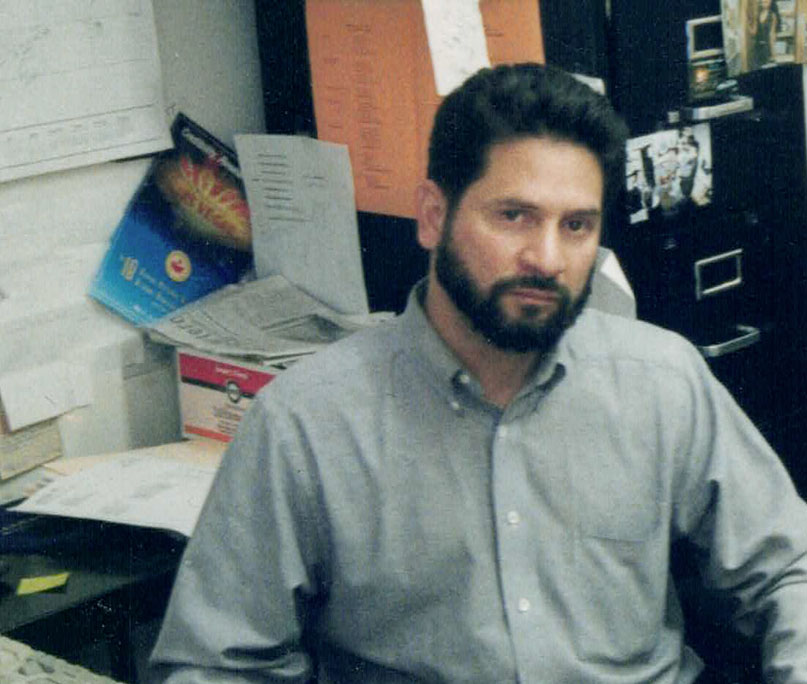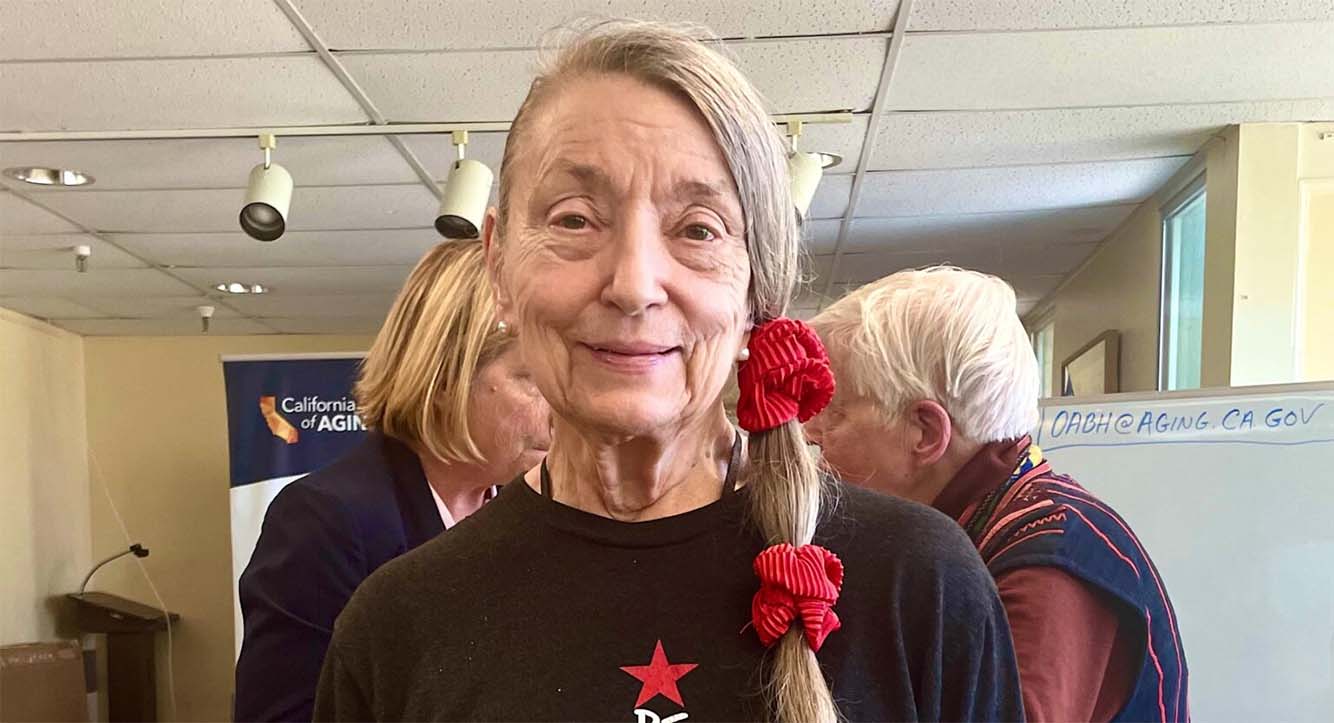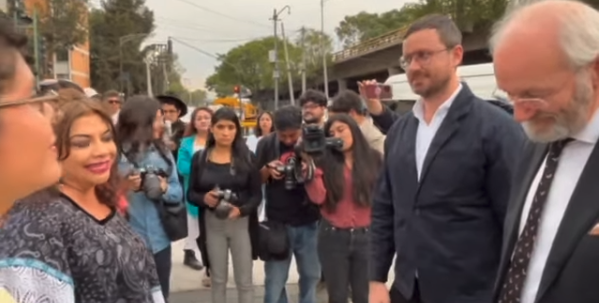Julian Assange’s father and brother ended a 48-day North American tour in Mexico City, getting the president’s support and a letter from Mexican MPs to Joe Biden demanding he drop the charges, reports Joe Lauria from Mexico
by Joe Lauria, in Mexico City
Special to Consortium News
John and Gabriel Shipton have been on and off the road on three continents for three years appealing to ordinary citizens and the powerful about the plight of their son and brother, Julian Assange, imprisoned for possessing and publishing U.S. “defense information” that revealed prima facie evidence of state crimes.
The Shiptons are spreading their message through the documentary film Ithaka, produced by Assange’s brother, which chronicles the odyssey of their father in Britain, Europe and the United States in pursuit of his son’s freedom.
The Shiptons brought their film to Toronto and 55 cities across the U.S., meeting in cinemas and universities from New York to Tulsa to Decatur, GA.
Their campaign ended its 7-week North American tour at the end of April in Mexico, where they were embraced not only by Mexicans in the street but by the country’s highest office holder and members of Parliament. The Shiptons received a firm endorsement from the president and a letter from national legislators to Joe Biden demanding he let Assange go.
‘Tear Down the Statue of Liberty’
The Shiptons met President Andrés Manuel López Obrador for an hour on April 20 at the historic Palacio Nacional, built in 1522 on the site of the Aztec ruler Moctezuma II’s palace. It houses some of Diego Rivera’s finest murals. Obrador moved his residence and offices there in 2018.
On July 4, 2022, U.S. Independence Day, Obrador told a news conference: “If they take [Assange] to the United States and he is sentenced to the maximum penalty and to die in prison, we must start a campaign to tear down the Statue of Liberty.”
Eight days later, on July 12, Obrador met Biden in the White House. Afterward, he said,
“I left a letter to the president about Assange, explaining that he did not commit any serious crime, did not cause anyone’s death, did not violate any human rights and that he exercised his freedom, and that arresting him would mean a permanent affront to freedom of expression.”
Obrador has twice offered political aslyum to Assange, whom he’s called “the best journalist of our time.”
John Shipton told Consortium News after his meeting with Obrador that he admired the president’s guts. Gabriel Shipton said Obraror had “reconfirmed his unconditional support for Julian’s freedom.”
The unconvicted Assange has been incarcerated since April 2019 on remand in London’s harsh Belmarsh Prison awaiting a British decision on a U.S. demand that he be brought in chains to an Alexandria, Virginia courtroom.
There he would face charges under the controversial Espionage Act. If convicted, he could be sentenced to a maximum 175 years in a U.S. dungeon.
At a press conference at the Chamber of Deputies immediately after leaving the Palacio Nacional, John Shipton said there was “a new dawn” in the fight to free Assange. “The sunlight is brilliant and it is led by President Obrador.”
Shipton told Consortium News at the news briefing that in his meeting with the Mexican president “there was some indication” that Biden and Obrador have had a conversation about Assange, “but the details of that conversation I don’t know.”
Obrador has joined other Latin American leaders to form a pro-Assange bloc publicly advocating for his release. Shipton said the political movement to free his son “encompasses the entirety” of Latin America: including the presidents of Argentina, Brazil, Chile, Columbia, Venezuela and Mexico.
“This new power emanating from Latin America has begun a change in the geopolitical circumstances of the world,” Shipton said. “Important in that change is the freedom of Julian Assange and the freedom of each of us to speak to one another and publish what we think freely.”
Deputies Petition Biden
The Chamber of Deputies is an extraordinary place where citizens have set up markets to sell their wares on the Parliament grounds. It is a sign of the kind of community found in Mexico that would be impossible to see inside the gates of the U.S. Capitol, Westminster or at Parliament House in Canberra.
About thirty representatives joined the Shiptons at the Chamber of Deputies press conference, where lawmakers said a parliamentary group of 100 senators and deputies had also sent a letter to Biden, through the U.S. embassy, telling him to free Assange.
Parliaments in Australia, Britain and Brazil have similarly written to Biden. Seven U.S. members of Congress wrote to the U.S. attorney general arguing that Assange should be set free.
“This puts Mexican lawmakers in the forefront of a global movement for freedom of expression,” Gabriel Shipton told the press conference. “They are speaking up with a growing movement all around the world calling for Julian’s freedom, but also for all of our freedom.”
He called on the Mexican lawmakers to form friendship groups with legislators who support Assange in other countries, and to also put forward motions in Parliament in support of his brother.
The Mexican legislators at the press conference indeed announced they would be forming a permanent commission to work “with our counterparts in the U.S. Congress to not leave a single day to not demand the immediate release of Julian Assange.” The commission will also reach out to like-minded members in the British parliament.
John Shipton told the press conference that there were cross-party groups supporting Assange across the world: one-third of the Greek parliament; 50 in the Australian legislature; 25 in Westminster and as many as 90 in the Bundestag. He said he’d now like to see the U.S. Congress pass a motion supporting his son.
“We are seeing before us a global problem, which requires a global movement,” he said, that includes “the press, parliaments, the institutions of state and as demonstrated in Latin America by the presidents of the great states of Latin America.”
Greeted in the Street
After they left the Chamber of Deputies, the Shiptons toured a recently opened museum dedicated to climate change and biodiversity called Barco Utopia.
As they arrived from their bus they were greeted by a crowd in the street.
Mexican Premier
On the following night the Mexican premier of Ithaka was held in a packed auditorium at Instituto Nacional de Formation Política.
Journalist Alina Duarte told the audience that WikiLeaks had published cables that revealed the government of President Felipe Calderon (2006-2012) “was willing to integrate, to deliver … our national security, our territory — it didn’t matter at what cost — … to the Barack Obama administration, everything that it required.”
Duarte said the cables revealed that leftist leaders in Mexico were spied on by the U.S. at that time, including Obrador. The Mexican corporate media had a pact with government in 2011 not to report any of these details, she said.
John Shipton told the audience that he and Gabriel had conducted 61 such question and answer sessions on their North American tour. “The further south we traveled the warmer the climate got and the warmer the people,” he said.
Asked what were the chances of Assange obtaining asylum in Mexico, Shipton said it was up to the Latin American presidents who back Assange. He said it depended on “the influence that these great nations of South America, together, in concert exercise in … Washington.”
Gabriel Shipton called on the audience to press their representatives in the Chamber of Deputies to make sure they begin their work on Assange’s case with the permanent commission in the chamber, which would be the first of its kind in any parliament. “Sometimes politicians like to say something, and then forget,” he said. “So they need the media, the journalists to keep them accountable.”
Asked how youth organizations can be brought into the Assange movement, John Shipton said: “Obrador informed us that freedom in Mexico — sovereignty — came at the cost of six wars; against France, one, against Spain, one, against the United States, four.”
Shipton said that on the previous day there had been a celebration in Veracruz of the “defeat of the United States incursion in 1914 into Mexico to steal more land.” He said:
“We see from that, that your sovereignty, your freedom, your freedom to be Mexico exists, and it rose upon the tears of women and the blood of men. To teach this to young people is understanding that it came only on the tears of mothers, daughters, wives and the cries of children.”
This is the “vital lesson” to teach the young, he said, “of the creation of what we know now as Mexico.” Shipton went on:
“We also learned from Lopez Obrador that this history has to be available to us. And that Julian Assange is an example of the importance of information and knowledge available to us to understand how we came to be and how Mexico can continue to be. These great themes of nation and sovereignty, and information and history come together in the persecution of Julian Assange.
So in understanding and teaching us, Obrador furthers the capacity and the defense of sovereignty in every nation; of freedom of every person; and subsequently his asking for the freedom, and demanding the freedom of Julian Assange.”
In response to a question about how people in the U.S. reacted to the Shiptons’ tour, Gabriel Shipton said,
“They are very concerned because it is their rights, their constitutional rights through the First Amendment that this prosecution of Julian is affecting also. So many people we meet all through the United States, whether they’re on the right or on the left, they all support what we are doing because they can see how it affects them. How it affects their own democracy. They are very emotional as well. Some audiences were in tears … because of the injustice they can see on screen. We all have inside a yearning for justice and revulsion for injustice.”
Returning to the theme of the importance of knowledge and WikiLeaks’ role in disseminating it, John Shipton told the following story:
“When Rafael Correa won government in Ecuador, he read the files in the Cables set about Ecuador. One of the files revealed that the United States embassy was paying the wages of the elite police force in Ecuador. Confronted with this problem, to establish a stable government, he came up with an elegant solution: pay all the police force the same wage as the elite police were getting. So he had a stable government. So, with wit and knowledge we will prevail.”
Back Home
The Shiptons headed home to Australia the day after the screening to continue lobbying a Labor government in Canberra that has been perfecting the art of sitting on the fence when it comes to their citizen Assange.
After pressure, Prime Minister Anthony Albanese at last revealed in an ABC interview last week that he has made his position clear to the U.S. Justice Department. “We’re working through diplomatic channels, we’re making very clear what our position is on Mr Assange’s case,” Albanese said. “This needs to be brought to a conclusion.”
The North American tour, the growing number of world leaders and parliamentary groups, the human rights and press freedom organizations, and direct action such as by Code Pink on Antony Blinken’s stage on World Press Freedom Day, underscores the significantly increased pressure on the Biden administration to release Assange.
The U.S. knows what it is up against. Biden knows. In 2010 he said there was no evidence to charge Assange and the administration he belonged to did not charge him. There is no new evidence since then in the case, but the Trump administration indicted him anyway, and Biden has continued to pursue that prosecution.
Though it forms no part of the indictment, the Democratic Party and the C.I.A. have been incensed by WikiLeaks releases that affected them and Biden would likely face their wrath were he to release Assange.
Nevertheless, this growing movement of presidents, parliaments, the public and human rights and press freedom groups is sending a clear message to Washington: the world can see through U.S. “values” when that includes locking up a journalist who was just doing his job.
Australian MPs Meet Kennedy
With Biden just two weeks from a visit to Australia he is starting to get the message even more directly. A cross party delegation of Australian legislators met on Tuesday morning in Canberra with Caroline Kennedy, the U.S. ambassador. MP Julian Hill pushed for the meeting. The Sydney Morning Herald quoted Senator Andrew Wilkie as saying:
“This is an intensely important time with the US President about to visit. It would be very unhelpful if he comes to Australia and this issue is still unresolved, it will hang over us all in an uncomfortable way.”
“The US and Australia have a very important and close relationship, and it’s time to demonstrate that.” Wilkie said. Senator David Shoebridge, who also met with Kennedy, was quoted as saying: “The fact that the ambassador allocated precious time to this issue ahead of President Biden’s visit is a useful indication of the visibility of the campaign to free Assange.”
Shoebridge said: “The end of Australia’s ‘quiet diplomacy’ on Assange last week is an important step forward and brings us closer to a just conclusion of the ongoing persecution of Julian Assange.”
(Joe Lauria is editor-in-chief of Consortium News and a former U.N. correspondent for The Wall Street Journal, Boston Globe, and numerous other newspapers, including The Montreal Gazette and The Star of Johannesburg. He was an investigative reporter for the Sunday Times of London, a financial reporter for Bloomberg News and began his professional work as a 19-year old stringer for The New York Times. He can be reached at joelauria@consortiumnews.com and followed on Twitter @unjoe)











